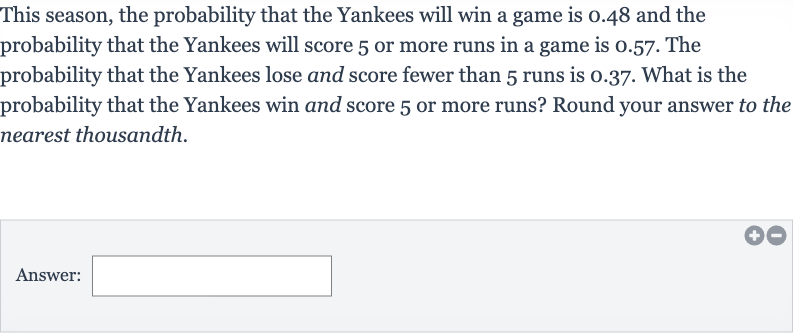AI tutor
Welcome to Bytelearn!
Let’s check out your problem:

This season, the probability that the Yankees will win a game is . and the probability that the Yankees will score or more runs in a game is . . The probability that the Yankees lose and score fewer than runs is . . What is the probability that the Yankees win and score or more runs? Round your answer to the nearest thousandth.Answer:
Full solution
Q. This season, the probability that the Yankees will win a game is . and the probability that the Yankees will score or more runs in a game is . . The probability that the Yankees lose and score fewer than runs is . . What is the probability that the Yankees win and score or more runs? Round your answer to the nearest thousandth.Answer:
- Events Denoted: Let's denote the events as follows:W: The Yankees win a game.S: The Yankees score or more runs in a game.L: The Yankees lose a game.F: The Yankees score fewer than runs in a game.We are given the following probabilities:We know that the probability of the Yankees losing a game is the complement of the probability of them winning a game. Therefore, we can calculate as:
- Calculate : Similarly, the probability of the Yankees scoring fewer than runs is the complement of the probability of them scoring or more runs. So we can calculate as:
- Calculate P(F): Now, we want to find the probability that the Yankees win and score or more runs, which is . We can use the complement of the event to help us find this probability. Since is the probability of both losing and scoring fewer than runs, the complement will give us the probability of either winning or scoring or more runs. We can express this as:
- Find : However, includes all the possibilities of winning (regardless of the number of runs) and scoring or more runs (regardless of winning or losing). To find , we need to subtract the probabilities of winning without scoring or more runs and scoring or more runs without winning from . This can be expressed as:
- Substitute and Solve: Substituting the values we have:
More problems from Find probabilities using the addition rule
QuestionGet tutor help
QuestionGet tutor help
QuestionGet tutor help
QuestionGet tutor help
QuestionGet tutor help
QuestionGet tutor help
QuestionGet tutor help
QuestionGet tutor help
QuestionGet tutor help
